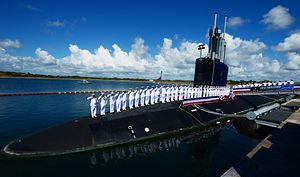The U.S. Navy’s latest Virginia-class nuclear-powered fast attack submarine (SSN), the USS Indiana (SSN 789), was commissioned at the Navy Port at Cape Canaveral Air Force Station in Port Canaveral, Florida on September 29, the service announced in a recent statement.
The 7,800-ton boat, which began construction in 2012, is the 16th Virginia-class SSN to join the fleet and the sixth Block III contract attack submarine to enter service. (Virginia-class SSNs are built in block increments, with Block I and Block II already delivered to the U.S. Navy.)
The Indiana was christened in April 2017 and launched in June of the same year. The Indiana successfully completed its initial set of sea trials — known as alpha trials — in June.
The USS Indiana was brought to life during a ceremony attended by Secretary of the Navy Richard V. Spencer. “The future USS Indiana shows the increased capabilities that our industrial partners bring to the fleet as we deliver the Navy the nation needs,” said Spencer on Saturday. “This submarine sends a signal to friend and foe alike that we will maintain supremacy under the waves, and extend our lethality and readiness in every domain.”
In comparison to Block I and II boats, Virginia-class attack Block III SSSN are equipped with the so-called Virginia Payload Module (VPM) – two large-diameter tubes that replace 12 individual vertical launch tubes and increase the submarine’s missile payload at a lower cost. As I explained previously:
While the first 10 Block I and Block II Virginia-class submarines feature 12 individual 21-inch diameter vertical launch tubes able to fire Tomahawk Land Attack Missiles (TLAMS), “the Block III submarines are built with two-larger 87-inch diameter tubes able to house six TLAMS each,” according to the U.S. Navy website. The new 87-inch tubes have been designed to accommodate future missile systems in addition to the Tomahawk.
In addition, Virginia-class Block III boats are equipped with four torpedo tubes for MK48 torpedoes. Furthermore, next to a redesigned bow, Block III Virginia-class boats also contain “a water-backed Large Aperture Bow (LAB) sonar array that replaces the air-backed sonar sphere found in the first 10 Virginias.” This, in combination with the its so-called fly-by-wire capability, enables the boat to perform important intelligence and surveillance missions.
Virginia-class SSNs are among the most advanced attack submarines in the world. “Their inherent stealth, endurance, mobility, and firepower directly enable them to support five of the six maritime strategy core capabilities — sea control, power projection, forward presence, maritime security, and deterrence,” the U.S. Navy said in a September 27 release.
The submarine, with a crew of about 135 sailors, can carry up to 24 torpedoes and Tomahawk cruise missiles. The boat’s top underwater speed is about 25 knots or 46 kilometers per hour. The USS Indiana’s reactor plant will not require refueling during the ship’s lifetime.
On September 24, the U.S. Navy took delivery of the 17th Virginia-class SSN, the future USS South Dakota (SSN 790), during a ceremony at General Dynamics Electric Boat Shipyard in Groton, Connecticut. The South Dakota, which was laid down in 2013, is the seventh Virginia-class Block III submarine. The submarine is expected to be commissioned in early 2019.

































